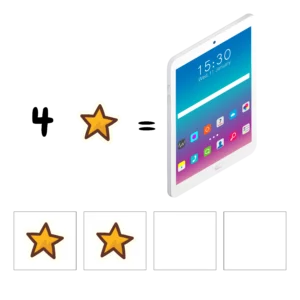Token Systems
Table of Contents
In this post, we will be covering token systems, task number thirteen on the RBT Competency Assessment. Token systems are a widely used technique in Applied Behavior Analysis (ABA) that involve providing tokens as a form of reinforcement for desired behaviors. These tokens can later be exchanged for preferred items or activities, helping to motivate and encourage positive behavior change.
Welcome back to our RBT Competency Assessment blog post series! In this series, we are exploring each task on the RBT Competency Assessment to help new Behavior Technicians (BTs) prepare for their initial competency assessments and provide a valuable refresher for Registered Behavior Technicians (RBTs) renewing their certification.
We will cover what token systems are, why they are important, and how they are used in ABA. Additionally, we will provide a detailed example of a token system in action to help you understand its practical application. By mastering these techniques, RBTs can significantly enhance their ability to manage behavior and promote skill acquisition in their clients. Let’s begin by defining token systems and discussing their role and significance in ABA.
What are Token Systems?
Definition and Explanation: Token systems, also known as token economies, are a form of behavior modification strategy used in ABA to reinforce desired behaviors. In a token system, individuals earn tokens for engaging in specific target behaviors. These tokens act as a form of currency that can be exchanged for preferred items, activities, or privileges. Tokens can take various forms, such as stickers, points, chips, or any other tangible item that can be accumulated and exchanged.
Different Types of Token Systems:
- Sticker Charts: Learners earn stickers for each instance of the desired behavior, which they can exchange for a reward after collecting a certain number.
- Point Systems: Points are awarded for specific behaviors, which can then be redeemed for larger rewards.
- Chip or Token Boards: Learners collect tokens, such as poker chips or other tangible items, that can be traded for preferred items or activities.

Why are Token Systems Important?
Benefits of Using Token Systems in ABA:
- Increases Motivation: Token systems provide immediate reinforcement, which helps maintain the learner’s motivation to engage in desired behaviors.
- Visual Feedback: Tokens offer a visual representation of progress, helping learners understand the connection between their behavior and the rewards.
- Promotes Positive Behavior: By consistently rewarding desired behaviors, token systems help in reducing maladaptive behaviors and promoting positive behavior changes.
- Customizable: Token systems can be tailored to individual learners’ preferences and needs, making them highly effective for a wide range of behaviors and skill levels.
How Token Systems Help in Behavior Management and Skill Acquisition:
- Behavior Management: Token systems help in managing challenging behaviors by providing a structured and predictable reinforcement system. Learners know exactly what behaviors will earn them tokens and what rewards they can work towards.
- Skill Acquisition: By reinforcing desired behaviors, token systems encourage the repetition of these behaviors, leading to the acquisition of new skills. Over time, learners develop positive habits and behaviors through consistent reinforcement.
How Token Systems are Used in ABA
Detailed Explanation of the Token System Process: In ABA, token systems are used to reinforce desired behaviors by providing a structured and predictable method of reinforcement. The process involves identifying target behaviors, awarding tokens for these behaviors, and allowing the learner to exchange the tokens for preferred items or activities. This method helps learners understand the connection between their behavior and the rewards they receive, promoting positive behavior change and skill acquisition.
Strategies for Implementing Token Systems Effectively:
- Define Target Behaviors: Clearly identify the specific behaviors that will be reinforced with tokens.
- Select Appropriate Tokens: Choose tokens that are tangible and meaningful to the learner, such as stickers, points, or chips.
- Determine the Exchange Rate: Establish how many tokens are needed to earn a reward and what types of rewards are available.
- Consistent Implementation: Ensure that tokens are awarded consistently for the target behaviors and that the exchange process is straightforward and reliable.
- Adjust as Needed: Monitor the learner’s progress and adjust the token system as needed to maintain motivation and effectiveness.
Example of a Token System: Earning Car Tokens for Transitions
Scenario: Our learner needs to earn 5 car tokens to gain access to playing with toy cars. The client earns a token each time they transition to a new location in the clinic without engaging in maladaptive behavior.
Step-by-Step Process:
- Define Target Behavior: The target behavior is transitioning to a new location without engaging in maladaptive behavior.
- Select Tokens: Car-shaped tokens are used as the reinforcer.
- Introduce the Token System: Explain to the learner that they will earn a car token each time they successfully transition without any maladaptive behavior.
- Award Tokens: Each time the learner completes a transition successfully, immediately provide a car token that they get to place on the token board and offer verbal praise (e.g., “Great job moving to the next room with a calm body and nice hands!”).
- Track Progress: Keep a token board where the learner can see their accumulated tokens and understand how many more are needed to earn the reward.
- Exchange Tokens: Once the learner earns 5 car tokens, they can exchange them for access to play with the toy cars.
- Adjust as Needed: If the learner struggles or succeeds consistently, adjust the number of tokens required or the behaviors reinforced to keep the system effective and motivating.
By following these steps, RBTs can effectively implement token systems to encourage positive behavior and support skill development in their clients.
FAQ on Token Systems
The following FAQ section consists of the four most Googled questions on the topic of token systems.
- Q: What is a token system in ABA?
- A: A token system in ABA is a behavior modification technique where learners earn tokens for displaying desired behaviors. These tokens can later be exchanged for preferred items or activities, reinforcing positive behavior.
- Q: What is the token system?
- A: A token system is a structured method of providing reinforcement. Individuals receive tokens for specific behaviors, which they can accumulate and trade for rewards. This system helps motivate and encourage consistent positive behavior.
- Q: What are examples of token economy systems?
- A: Examples of token economy systems include sticker charts, where learners earn stickers for completing tasks, and point systems, where points are awarded for positive behaviors and can be exchanged for privileges or items.
- Q: How to use a token system?
- A: To use a token system, define the target behaviors, choose appropriate tokens, set an exchange rate for rewards, consistently award tokens for desired behaviors, and allow the learner to trade tokens for rewards. Adjust the system as needed to maintain effectiveness.
Final Thoughts
Token systems are a powerful tool in Applied Behavior Analysis (ABA) for promoting positive behavior and skill acquisition. By providing a structured and predictable method of reinforcement, token systems help learners understand the connection between their behavior and the rewards they receive. This approach not only increases motivation but also supports the development of new skills and the reduction of maladaptive behaviors.
Understanding and implementing token systems effectively is essential for any RBT. These systems offer flexibility and can be tailored to meet the individual needs of learners, making them a versatile and valuable strategy in behavior management. By mastering token systems, RBTs can make a significant impact on their clients’ progress and overall success.
Explore More Resources
If you found this guide on token systems in ABA helpful, be sure to explore more resources on our website. We offer a wealth of information, including detailed articles, study guides, and practical tips to help you succeed as a Registered Behavior Technician (RBT).
Are you preparing for the RBT competency assessment? Check out our comprehensive study materials and mock exams designed to help you ace the test and become a confident, competent RBT.
For more information on becoming a Registered Behavior Technician and for the latest research and resources in Applied Behavior Analysis, visit the Behavior Analyst Certification Board (BACB) website.
Share this blog with your peers and colleagues to spread the knowledge and support the ABA community!



